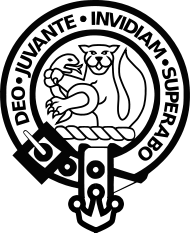CREST: A demi-cat-a-mountain rampant guardant Proper, grasping in his dexter paw a serpent Vert, langued Gules, its tail environing the sinister paw
MOTTO: Deo Juvante Invidiam Superabo: With God's help I will overcome envy
SEPTS:
Combie, MacOmie, MacOmish, McColm, McComas, McComb, McCombe, McCombie, McComie, McComish, Tam, Thom, Thomas, Thoms, Thomson
Thomas, a Gaelic speaking Highlander, known as Tomaidh Mor ('Great Tommy'), from whom the clan takes its name, was a descendant of the Clan Chattan Mackintoshes, his grandfather having been a son of William, 8th Chief of Clan Chattan. Thomas lived in the 15th century, at a time when the Clan Chattan Confederation had become large and unmanageable and so he took his kinsmen and followers across the Grampians, from Badenoch to Glenshee where they settled and flourished, being known as McComie (phonetic form of the Gaelic MacThomaidh), McColm and McComas (from MacThom and MacThomas). To the Government in Edinburgh, they were known as MacThomas and are so described in the Roll of the Clans in the Acts of the Scottish Parliament of 1587 and 1595 and MacThomas remains the official name of the Clan to this day. The early chiefs of the Clan MacThomas were seated at the Thom, on the east bank of the Shee Water opposite the Spittal of Glenshee, the site thought to be that of the tomb of the legendary Diarmid of the Fingalian saga, with which Glenshee has so many associations. In about 1600, when the 4th Chief, Robert MacThomaidh of the Thom was murdered, the chiefship passed to his brother, John McComie of Finegand, about three miles down the Glen, which became the seat of the chiefs. Finegand is a corruption of the Gaelic 'Feith nen Ceann' meaning 'burn of the heads' and refers to the time when some tax collectors were attacked by some clansmen, who cut off their heads and threw them in a nearby burn. By now, the MacThomases had acquired a lot of property in the glen and houses were well established at Kerrow and Benzian with shielings up Glen Beag. The time was spent breeding cattle and fighting off those seeking to rustle them, one such skirmish, in 1606, being remembered as the Battle of the Cairnwell. The 7th Chief was John McComie (Iain Mor) and his deeds have passed into the folklore of Perthshire and Angus, wherein he is generally known as 'McComie Mor'. The legends surrounding this Highland hero abound: he puts to flight some tax collectors in defence of a poor widow single handed; he kills the Earl of Atholl's champion swordsman; he slays the man who insulted his wife; he fights his son in disguise to test his courage: he overcomes a ferocious bull with his bare hands: and he is even familiar with the supernatural. Today, a large stone at the head of Glen Prosen is known as McComie Mor's Putting Stone, a nearby spring as McComie Mor's well, while at the top of Glen Beannie, a rock shaped like a seat is called McComie Mor's Chair.
For a printable pdf with more information, click
HERE
